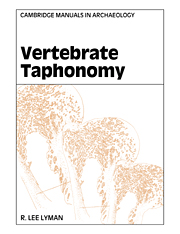Book contents
- Frontmatter
- Dedication
- Contents
- List of figures
- List of tables
- Preface
- Acknowledgements
- 1 WHAT IS TAPHONOMY?
- 2 THE HISTORY AND STRUCTURE OF TAPHONOMY
- 3 TAPHONOMY IN PRACTICE AND THEORY
- 4 STRUCTURE AND QUANTIFICATION OF VERTEBRATE SKELETONS
- 5 VERTEBRATE MORTALITY, SKELETONIZATION, DISARTICULATION, AND SCATTERING
- 6 ACCUMULATION AND DISPERSAL OF VERTEBRATE REMAINS
- 7 FREQUENCIES OF SKELETAL PARTS
- 8 BUTCHERING, BONE FRACTURING, AND BONE TOOLS
- 9 OTHER BIOSTRATINOMIC FACTORS
- 10 BURIAL AS A TAPHONOMIC PROCESS
- 11 DIAGENESIS
- 12 TAPHONOMY OF FISH, BIRDS, REPTILES, AND AMPHIBIANS
- 13 DISCUSSION AND CONCLUSIONS
- Bibliography
- Glossary of taphonomy terminology
- Index
8 - BUTCHERING, BONE FRACTURING, AND BONE TOOLS
Published online by Cambridge University Press: 05 August 2014
- Frontmatter
- Dedication
- Contents
- List of figures
- List of tables
- Preface
- Acknowledgements
- 1 WHAT IS TAPHONOMY?
- 2 THE HISTORY AND STRUCTURE OF TAPHONOMY
- 3 TAPHONOMY IN PRACTICE AND THEORY
- 4 STRUCTURE AND QUANTIFICATION OF VERTEBRATE SKELETONS
- 5 VERTEBRATE MORTALITY, SKELETONIZATION, DISARTICULATION, AND SCATTERING
- 6 ACCUMULATION AND DISPERSAL OF VERTEBRATE REMAINS
- 7 FREQUENCIES OF SKELETAL PARTS
- 8 BUTCHERING, BONE FRACTURING, AND BONE TOOLS
- 9 OTHER BIOSTRATINOMIC FACTORS
- 10 BURIAL AS A TAPHONOMIC PROCESS
- 11 DIAGENESIS
- 12 TAPHONOMY OF FISH, BIRDS, REPTILES, AND AMPHIBIANS
- 13 DISCUSSION AND CONCLUSIONS
- Bibliography
- Glossary of taphonomy terminology
- Index
Summary
Introduction
The manner in which animal carcasses and skeletal elements come apart or are taken apart is an important taphonomic variable. Humans butcher animals and that behavior often, but not always, variously modifies bones. In fact, it might be argued that butchering animal carcasses is the single greatest taphonomic (and biostratinomic) factor in the formation of humanly created fossil assemblages. Humans exploit animals for a variety of reasons, but basically to extract resources, whether energy (food) or materials for tools or clothing. During that exploitation, skeletons are disarticulated and bones are broken and variously modified. But as we have seen in previous chapters (especially Chapter 6), non-human taphonomic processes can result in the disarticulation of skeletons and fragmentation of bones. In this chapter, I review these processes, focusing on the modification of skeletal elements for which hominids in particular are responsible.
Butchering
The fragments of Aurochs exhibiting very deep incisions, apparently made by an instrument having a waved edge … in which I thought I recognized significant marks of utilization and flaying of a recently slain animal, were obtained from the lowest layer in the cutting of the Canal de l'Ourcq, near Paris … I have obtained analogous results by employing as a saw those flint knives found in the sands of Abbeville.
(E. Lartet 1860 [1969:122])The term butchering tends to hold different connotations for different analysts. Perhaps that is because it has seldom been explicitly defined.
- Type
- Chapter
- Information
- Vertebrate Taphonomy , pp. 294 - 353Publisher: Cambridge University PressPrint publication year: 1994
- 4
- Cited by

